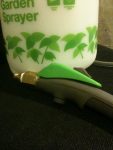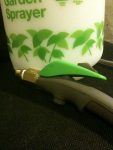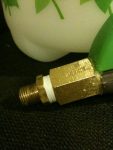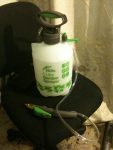So here’s the latest project I’ve been working on – a field airbrush.
Much as I love airbrushes, they’re not that outdoors friendly. My current studio setup is a waist-high compressed air cylinder, going through a regulator and “powering” a pair of airbrushes. I’m probably going to replace this with a portable compressor setup soon, but in the meantime I wanted to be able to have the ability to use an airbrush when out of range of power. You can get aerosol cans to do the job, but I wanted something a bit more sustainable and able to be recharged in the field.
The main component is a 5 litre garden spray bottle. This has a pump handle in the lid to compress the air inside. Normally you’d put liquid in it that you wanted to spray, but here we’re keeping it dry.
The brass fittings are attached where the sprayer wand is unscrewed from the handle. The connection of plastic to metal is a bit tricky – you need to bulk it up with teflon plumber’s tape and silicone sealant to get a good seal. The brass fitting will cut into the tape and plastic, so the silicone is necessary. The smaller brass piece only needed tape to seal. I bought the brass fittings from a plumbing supplies place so they were able to match the airbrush’s airline cap thread and diameter.
The way it works is that you pump up the cylinder (which has a safety release valve so you can’t over-pressurise). The original trigger for the sprayer is still inline so that allows you to unplug the airbrush without losing pressure. It also allows you to isolate the metal / plastic connection from constant pressure. The trigger has a button to lock the valve open, so you don’t have to keep it pressed by hand.
In use, you get about 4-5 minutes continuous air from one fill of the tank. You can easily keep the system pressurised by continuing to pump the system with your other hand while using the airbrush.
Total cost, about $35.




